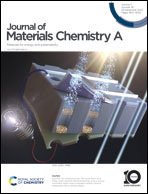Reforming material chemistry of CIGS solar cells via a precise Ag doping strategy†
Abstract
The slowing pace of improvement in traditional inorganic material-based solar cells requires innovation in device configurations and materials engineering. In this study, a small amount of Ag was incorporated at different points during a three-stage co-evaporation process for Cu(In,Ga)Se2 (CIGS) absorbers to improve the device performance of CIGS solar cells. The chemical compositions of the absorbers were controlled to be invariant, whereas the timing of in situ Ag incorporation (∼1.5 at% in total) was varied from the first stage to the second stage. The changes in the solar cell characteristics are discussed in relation to the changes in the material chemistry of the devices. Advanced material characterization studies, including atom probe tomography and Kelvin probe force microscopy, revealed that even a small addition of Ag resulted in significant changes in the film microstructure, alkali distribution, and electrostatic conditions of bulk CIGS. Furthermore, the timing of the Ag incorporation was an important factor; Ag addition in the first stage achieved more efficient carrier transport and improved the open-circuit voltage of the resulting devices. This study suggests an effective method to fabricate highly efficient CIGS solar cells using a simple and accurate Ag incorporation strategy.

- This article is part of the themed collection: #MyFirstJMCA


 Please wait while we load your content...
Please wait while we load your content...